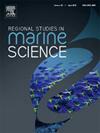Differential response in land use pattern, haematological parameters and growth of mudskipper (Apocryptes bato) at different salinities
IF 2.1
4区 环境科学与生态学
Q3 ECOLOGY
引用次数: 0
Abstract
Salinity is one of the ecological factors directly linked to the aquatic ecosystem and regulates the physiology of fish. To date very few is known about the aftereffects of salinity change due to climate change on the coastal species, especially the common intertidal mangrove mudskipper, Apocryptes bato (Gobiidae: Oxodurcinae), a commercially important fish species. In this study, A. bato was subjected to different salinities (5, 10, 12 and 15 ‰) for a period of 21 days. Salinity significantly influenced the land-use pattern diurnally in this species. At 5 and 15 ‰, mudskipper was found to spend significantly higher time on land during nighttime and in saline water during daytime compared to the 10 and 12 ‰. However, behavioural observations in the aquarium did not show significant alterations in the amount of time spend on land or water by individuals nor there were differences in the number of holes, channels in the mud, jumping, or feeding. Haematological analysis after 21 days of rearing showed elevated blood glucose levels in fish reared at 5 and 15 ‰ indicating stressful conditions at these salinities. In addition, higher frequencies of cellular and nuclear abnormalities such as twin cell, nuclear budding, micronucleus, bi-nucleus, triplet cell, tear-dropped cell, multiple nuclei and dead cells were observed in fish reared at 5 and 15 ‰. The growth of A. bato was also significantly impacted by the salinities with higher growth performance at 10 and 12 ‰ compared to 5 and 15 ‰. The findings of the present study suggest that both decreased and increased salinity significantly affected the land use pattern, haematology and growth of mudskippers which could be helpful in the conservation, management and coastal aquaculture.
求助全文
约1分钟内获得全文
求助全文
来源期刊

Regional Studies in Marine Science
Agricultural and Biological Sciences-Ecology, Evolution, Behavior and Systematics
CiteScore
3.90
自引率
4.80%
发文量
336
审稿时长
69 days
期刊介绍:
REGIONAL STUDIES IN MARINE SCIENCE will publish scientifically sound papers on regional aspects of maritime and marine resources in estuaries, coastal zones, continental shelf, the seas and oceans.
 求助内容:
求助内容: 应助结果提醒方式:
应助结果提醒方式:


